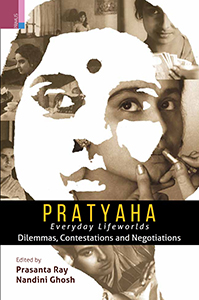
Pratyaha: Everyday Lifeworlds Dilemmas, Contestations and Negotiations
EDITOR- Prasanta Ray and Nandini Ghosh
| HB ₹1650 . $74.95 . ₤49.95 |
||
INFORMATION
- EDITOR : Prasanta Ray and Nandini Ghosh
- HB ISBN : 978-93-84082-40-6
- Year : 2015
- Extent : viii + 334 pp.
- Discount available on checkout
- Usually dispatched within 3 to 5 working days.
Pratyaha
| HB ₹ 1650 . $ . ₤ |
PB ₹ . $ . ₤ |
|
| POD ₹ . $ . ₤ |
e-Book ₹ . $ . ₤ |
INFORMATION
- AUTHOR – Prasanta Ray and Nandini Ghosh
- ISBN – 978-93-84082-40-6
- Year – 2015
- Extent: 400 + 40 coloured illustrations
- 10% discount + free shipping
- Usually dispatched within 3 to 5 working days.
Pratyaha is the Sanskritized Bengali word for ‘everyday’ for everybody.
The neglect of everyday lifeworlds is due to a taken-for-granted belief that the realm of everyday is the site for common sense and the common place, the very well known, perhaps even the trivial. It is our sense of familiarity with routine relations and their sheer temporariness which casualizes our attitude towards our daily lived existence. True to the specific genre of critical everyday studies, the focus is on the dilemmas, contestations and negotiations between the self and the other, the ‘normal’ and the ‘unusual’, the sacral and the secular, and the explicit and the enigmatic. As usual, numerous actants play critical roles. In many of these reconstructions, women with different degrees of agency and powerlessness stand out as protagonists in the everyday dialectics, inescapably embedded in micro-structures and processes. Through a wide range of analytical modes, like narrative analysis, deconstructions of autobiographies, novels and children’s stories, use of index numbers, ethnography, and interpretation of myths, this multidisciplinary volume explores a variety of everyday intimacies and estrangements in different institutional settings in the everyday lifeworlds, mainly of the contemporary urban Indian middle class across Islamic, Christian and Hindu frames of living.
The Editors
Prasanta Ray is Professor Emeritus with Presidency University, Kolkata; Honorary Visiting Professor, Institute of Development Studies, Kolkata; and Member, Calcutta Research Group. He has authored Conflict and the State: An Exploration in the Behaviour of the Post-colonial state in India (1991).
Nandini Ghosh is an Assistant Professor of Sociology with the Institute of Development Studies, Kolkata. She is also Guest Faculty with the Department of Sociology, Jadavpur University. Her article ‘Bhalo Meye: Cultural Construction of Gender and Disability in Bengal’ was published in Disability Studies in India: Global Discourses, Local Realities, edited by Renu Addlakha (2012).
Pratyaha is the Sanskritized Bengali word for ‘everyday’ for everybody.
The neglect of everyday lifeworlds is due to a taken-for-granted belief that the realm of everyday is the site for common sense and the common place, the very well known, perhaps even the trivial. It is our sense of familiarity with routine relations and their sheer temporariness which casualizes our attitude towards our daily lived existence. True to the specific genre of critical everyday studies, the focus is on the dilemmas, contestations and negotiations between the self and the other, the ‘normal’ and the ‘unusual’, the sacral and the secular, and the explicit and the enigmatic. As usual, numerous actants play critical roles. In many of these reconstructions, women with different degrees of agency and powerlessness stand out as protagonists in the everyday dialectics, inescapably embedded in micro-structures and processes. Through a wide range of analytical modes, like narrative analysis, deconstructions of autobiographies, novels and children’s stories, use of index numbers, ethnography, and interpretation of myths, this multidisciplinary volume explores a variety of everyday intimacies and estrangements in different institutional settings in the everyday lifeworlds, mainly of the contemporary urban Indian middle class across Islamic, Christian and Hindu frames of living.
The Author
Prasanta Ray is Professor Emeritus with Presidency University, Kolkata; Honorary Visiting Professor, Institute of Development Studies, Kolkata; and Member, Calcutta Research Group. He has authored Conflict and the State: An Exploration in the Behaviour of the Post-colonial state in India (1991).
Nandini Ghosh is an Assistant Professor of Sociology with the Institute of Development Studies, Kolkata. She is also Guest Faculty with the Department of Sociology, Jadavpur University. Her article ‘Bhalo Meye: Cultural Construction of Gender and Disability in Bengal’ was published in Disability Studies in India: Global Discourses, Local Realities, edited by Renu Addlakha (2012).
Table Of Contents
| Acknowledgements | vii |
| Introduction Prasanta Ray |
1-25 |
| 1. Sensitizing Theories Prasanta Ray |
26-65 |
| 2. Sensitive Ways of Knowing Prasanta Ray |
66-97 |
| 3. A Phoenix Everyday: An Academic’s Conscience in Ami Anupam, Phoenix and Disgrace Debarati Bandyopadhyay |
98-113 |
| 4. Everyday Life, Defamiliarization, and Desire in Moni Mohsin’s The End of Innocence Mosarrap Hossain Khan |
114-131 |
| 5. Voices Unsettling the Everyday: The Strange Case of the ‘Telephone’ in Bangla Literature Runa Das Chaudhuri |
132-153 |
| 6. A Pragmatic Intimacy? Familiality, Dependency and Social Subordination Samita Sen |
154-174 |
| 7. Predicament and Pride: The Everyday life of Anglo-Indian Women in Kolkata Sudarshana Sen |
175-193 |
| 8. Sobar Moto Noy: Not Like Others: Everyday Experiences of Women with Disabilities Nandini Ghosh |
194-213 |
| 9. Exploring the Everyday Lifeworld of Two Indian Goddesses: Renuka/Yellamma and Maa Manasa Sushmita Gonsalves Mondal |
214-237 |
| 10. Remembering the Pratyahik (Daily): ‘De’familiarizing Familial Social History through Memoirs Rukmini Sen |
238-258 |
| 11. ‘Sociality’ and Representations of Everyday Life of Sweetshops and Sweets Ishita Dey |
259-277 |
| 12. Anxious Hearths and Risky Meals: Re-imagining Domesticity in an Asian Worlding City Manpreet K. Janeja |
278-295 |
| 13. Everyday Consumption and Level of Living: Economists’ Approach Dipankor Coondoo |
296-314 |
| Notes on Editors and Contributors | 315-317 |
| Index | 319-333 |




